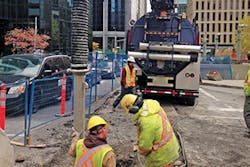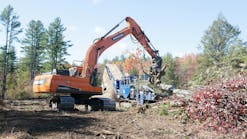Vacuum excavation equipment uses high-pressure air or water to control soft excavation—frequently to safely locate and uncover underground utilities. Soil is sucked through a vacuum hose and is deposited into a debris tank for later disposal, or for backfilling into the hole.
Customers for vacuum excavation technology appear to be targeting larger truck-mounted units for increased productivity and flexibility, says Ben Schmitt, product manager, Vactor Manufacturing. “The biggest trend is just the growing awareness of hydro excavation over conventional mechanical means.”
Vacuum excavation equipment uses high-pressure air or water to control soft excavation—frequently to safely locate and uncover underground utilities. Soil is sucked through a vacuum hose and is deposited into a debris tank for later disposal, or for backfilling into the hole. Customers for vacuum excavation technology appear to be targeting larger truck-mounted units for increased productivity and flexibility, says Ben Schmitt, product manager, Vactor Manufacturing. “The biggest trend is just the growing awareness of hydro excavation over conventional mechanical means.” [text_ad] Models range from large dedicated truck units to small trailer- or skid-mounted units, which gained popularity in the 1990s as support machines for horizontal directional drilling operations. The smallest vacuum excavation units even fit into the back of a pickup truck.Vac-Con Inc. is one of the companies that grew up alongside the increasing use of vacuum excavation. The company was established in 1986 to develop a truck-mounted combination sewer and catch basin cleaning machine to compete in the government and private contractor market segments. The founding philosophy was to provide powerful and efficient equipment that was easier to use and easier to maintain.While adhering to that philosophy, Vac-Con has expanded its product line to include industrial vacuum loaders and vacuum excavators, and has manufactured and distributed more than 7,000 machines, worldwide. Vac-Con started building vacuum excavation machines for the oil fields of Western Canada in the early 1990s, to be used in the standard “daylighting” process, as well as slot trenching operations. As the industry grew, the excavation market expanded to include municipal water authorities and major utilities, and ultimately to support the construction industry in a number of aspects, including directional drilling and underground utility locating, repair, and installation.Vac-Con now has a wide range of experience, from the simplest auxiliary hydro excavation packages on municipal combination machines, to the industry’s most powerful dual-blower machine with sophisticated hydrostatic drive and control systems for heavy excavation projects. The Vac-Con X-Cavator is being used throughout the US and around the world. Vac-Con machines are built in the United States at its manufacturing facility located in Green Cove Springs, FL. [caption id="attachment_20731" align="alignright" width="300"]Models range from large dedicated truck units to small trailer- or skid-mounted units, which gained popularity in the 1990s as support machines for horizontal directional drilling operations. The smallest vacuum excavation units even fit into the back of a pickup truck.Vac-Con Inc. is one of the companies that grew up alongside the increasing use of vacuum excavation. The company was established in 1986 to develop a truck-mounted combination sewer and catch basin cleaning machine to compete in the government and private contractor market segments.
The founding philosophy was to provide powerful and efficient equipment that was easier to use and easier to maintain.While adhering to that philosophy, Vac-Con has expanded its product line to include industrial vacuum loaders and vacuum excavators, and has manufactured and distributed more than 7,000 machines, worldwide. Vac-Con started building vacuum excavation machines for the oil fields of Western Canada in the early 1990s, to be used in the standard “daylighting” process, as well as slot trenching operations.
As the industry grew, the excavation market expanded to include municipal water authorities and major utilities, and ultimately to support the construction industry in a number of aspects, including directional drilling and underground utility locating, repair, and installation.Vac-Con now has a wide range of experience, from the simplest auxiliary hydro excavation packages on municipal combination machines, to the industry’s most powerful dual-blower machine with sophisticated hydrostatic drive and control systems for heavy excavation projects. The Vac-Con X-Cavator is being used throughout the US and around the world. Vac-Con machines are built in the United States at its manufacturing facility located in Green Cove Springs, FL.
Some utilities, transportation departments, or power plants specify air vacuum excavation for a number of reasons. Air vacuum excavation is desired in applications where the soil is loose, water is not readily available, or where immediate backfill of the hole is required. When working around buried electrical lines or brittle utilities, air vacuum excavation is often preferred due to the lower operating pressures.
Schmitt says the utility segment appears to amount to about 20% of the total vacuum excavation market. However, demand continues to increase rapidly in the oil and gas production sector.
“We have seen a great deal more regulations and requirements on methods of excavation near identified utilities and an increased focus on safe digging, which has been driving more need for vacuum excavators over the past four years,” says Jeff Wage, vice president of sales and marketing for McLaughlin, which manufactures the line of Vermeer Vacuum Excavators. “The increase in demand continues at an accelerated rate for this technology.”
Wage says he sees more focus on core drills for cutting a core in a road before potholing, which reduces time and excavation size and improves reinstatement of the pavement. “Moreover, we see a trend toward more 4-inch vacuum systems for potholing utilities and for staying on the job longer with larger tank capacities,” says Wage. “We see more users going to a four-inch suction hose and 50-hp-class machines with 1,025 cfm blowers to handle larger material and improved productivity. We also see this segment migrating toward diesel power for higher torque curves versus gasoline, while value priced gasoline vacs in the 25 to 30 hp class remain the norm for mud-sucking in horizontal drilling applications.”




